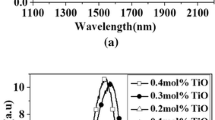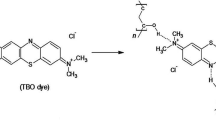Abstract
Silica–titania (ST) nanohybrid and bromophenol blue (BPB) immobilized ST nanohybrid matrix are synthesized by low-temperature sol–gel route. The influence of BPB on the structural, morphological, and nonlinear optical properties of silica–titania nanohybrid was investigated by fourier transform infrared spectroscopy (FTIR), transmission electron microscopy (TEM), atomic force microscopy (AFM), and z-scan technique. FTIR analysis confirms the chemical bonding between hydrophobic BPB dye species and hydrophilic type ST nanohybrid matrix. TEM and AFM analysis shows that the synthesized immobilized nanohybrid has inter-dispersed structure with average particle size of 0.8 ± 0.3 nm, smooth morphology, and low average surface roughness ~4.57 nm. The immobilization of BPB greatly improves the nonlinear refraction response and the nonlinear refractive index increases from 4.8 × 10–9 cm2/W to 451.9 × 10–9 cm2/W. Reverse saturable absorption is observed in both BPB and BPB/ST nanohybrid. However, the magnitude of nonlinear absorption coefficient in BPB/ST is lower than the BPB dye due to the occurrence of saturable absorption of the ST matrix. The optical limiting (OL) behavior of the BPB/ST nanohybrid reveals the low OL threshold at 0.33 kW/cm2. The synthesized BPB/ST nanohybrid has potential as an optical limiters for safety of photonic and optoelectronic devices under low-powered CW laser.

Bromophenol blue (BPB) immobilized silica–titania nanohybrid has been synthesized. FTIR analysis confirms the immobilization between hydrophobic BPB dye species and hydrophilic type ST nanohybrid matrix. The BPB/ST nanohybrid shows the inter-dispersed structure with homogeneous surface. The superior nonlinear refraction response and the nonlinear refractive index 4.52 × 10–7 cm2/W is obtained. The optical limiting action starts at low threshold, 0.33 kW/cm2
Highlights
-
Synthesis of silica–titania (ST) nanohybrid and bromophenol blue (BPB) immobilized ST nanohybrid matrix by sol–gel method is reported.
-
FTIR analysis confirms the chemical bonding between hydrophobic BPB dye species and hydrophilic type ST nanohybrid matrix.
-
TEM and AFM analysis shows the inter-dispersed structure with low average surface roughness ~4.57 nm.
-
The superior nonlinear refraction response and the nonlinear refractive index 4.52 × 10–7 cm2/W is obtained.
-
The optical limiting (OL) behavior revealed the low OL threshold at 0.33 kW/cm2.
-
The synthesized BPB-ST nanohybrid has potential as an optical limiters for safety of photonic and optoelectronic devices under low-powered CW laser.







Similar content being viewed by others
References
Liu X, Tomita Y (2012) Closed-aperture Z-scan analysis for nonlinear media with saturable absorption and simultaneous third- and fifth-order nonlinear refraction. Phys Res Int https://doi.org/10.1155/2012/161572
Sadr MH, Mohaddes Mohammadi V, Soltani B et al. (2016) Nonlinear optical responses of MoS4Cu4(PzMe3)6Cl2under low power CW He-Ne laser excitation. Opt (Stuttg) 127:6050–6055. https://doi.org/10.1016/j.ijleo.2016.04.051
Wang J, Chen Y, Li R, et al (2011) Nonlinear optical properties of graphene and carbon nanotube composites. Carbon Nanotub-Synth Charact Appl. https://doi.org/10.5772/16510
Khoo IC (2009) Nonlinear optics of liquid crystalline materials. Phys Rep 471:221–267. https://doi.org/10.1016/j.physrep.2009.01.001
Stevens N, Samaroo D, Akins DL (2017) Nonlinear optical switching properties of dye-doped inorganic/organic nanocomposite films. J Nonlinear Opt Phys Mater 26:1–14. https://doi.org/10.1142/S0218863517500151
Dolgaleva K, Boyd RW (2012) Local-field effects in nanostructured photonic materials. Adv Opt Photonics 4:1. https://doi.org/10.1364/AOP.4.000001
Smith DD, Yoon Y, Boyd RW et al. (1999) Z-scan measurement of the nonlinear absorption of a thin gold film. J Appl Phys 86:6200–6205. https://doi.org/10.1063/1.371675
Sheik-Bahae M, Said A, Wei TH et al. (1989) Z-Scan: A simple and sensitive technique for nonlinear refraction measurements. Spie 1148:41–51. https://doi.org/10.1117/12.962142
Hilonga A, Kim JK, Sarawade PB et al. (2012) Synthesis of mesoporous silica with superior properties suitable for green tire. J Ind Eng Chem 18:1841–1844. https://doi.org/10.1016/j.jiec.2012.04.015
Islam S, Bidin N, Riaz S, Naseem S (2018) Synthesis of optically active bromophenol blue encapsulated mesoporous silica–titania nanomatrix: structural and sensing characteristics. J Sol-Gel Sci Technol 85:231–242. https://doi.org/10.1007/s10971-017-4523-8
Ren P, Li Y, Zhang Y, et al (2016) Photoelectric properties of DSSCs sensitized by phloxine B and bromophenol blue. Int J Photoenergy https://doi.org/10.1155/2016/2135847
Mhaisagar YS, Joshi BN, Mahajan AM (2012) Surface texture modification of spin-coated SiO 2 xerogel thin films by TMCS silylation. Bull Mater Sci 35:151–155. https://doi.org/10.1007/s12034-012-0275-9
Lamrani MA, El Jouad M, Addou M et al. (2008) Influence of roughness surfaces on third-order nonlinear-optical properties of erbium-doped zinc oxide thin films. Spectrosc Lett 41:292–298. https://doi.org/10.1080/00387010802286692
Saravanan M, Sabari SG, Vinitha G (2018) Facile hydrothermal synthesis of CdFe2O4-reduced graphene oxide nanocomposites and their third-order nonlinear optical properties under CW excitation. J Mol Liq 256:519–526. https://doi.org/10.1016/j.molliq.2018.02.065
Kubheka G, Sanusi K, Mack J, Nyokong T (2018) Optical limiting properties of 3,5-dipyrenylvinyleneBODIPY dyes at 532 nm. Spectrochim Acta-Part A Mol Biomol Spectrosc 191:357–364. https://doi.org/10.1016/j.saa.2017.10.021
Pradeep C, Mathew S, Nithyaja B et al. (2014) Studies of nonlinear optical properties of PicoGreen dye using Z-scan technique. Appl Phys A Mater Sci Process 115:291–295. https://doi.org/10.1007/s00339-013-7814-0
Acknowledgements
Mundzir Abdullah acknowledges the financial support by the Universiti Teknologi Malaysia, through RMC under the postdoctoral fellowship (vote 04E08) for the performance and the management of the project. Corresponding author is grateful to the Malaysia Ministry of Education through the FRGS fund with vote 03EE89.
Author information
Authors and Affiliations
Corresponding author
Ethics declarations
Conflict of interest
The authors declare that they have no conflict of interest.
Additional information
Publisher’s note: Springer Nature remains neutral with regard to jurisdictional claims in published maps and institutional affiliations.
Rights and permissions
About this article
Cite this article
Abdullah, M., Bakhtiar, H., Islam, S. et al. Third-order nonlinearity and optical limiting properties of sol–gel-based bromophenol blue dye immobilized in silica–titania nanohybrid. J Sol-Gel Sci Technol 89, 361–369 (2019). https://doi.org/10.1007/s10971-018-4906-5
Received:
Accepted:
Published:
Issue Date:
DOI: https://doi.org/10.1007/s10971-018-4906-5




